After an afternoon kayaking outing on one of the last warm summer afternoons of the year, I returned to the dock where I’d put in to pry myself out of the cockpit. There was a man in the water hanging on to the end of the dock. I asked him how the water was, thinking he was in there to cool off, but he made it clear that he wasn’t swimming for pleasure: “My girlfriend threw my pants in the water and all my money is in the pockets.”
I peered into the water that was in my shadow. On the bottom I could just make out a shopping cart and a green ride-share bike, but no pants. He said they were farther out, but on that side of my kayak there was only glare. I hauled myself up on the dock and wished him luck, as much for finding his pants as for finding a new girlfriend.
On the drive home I regretted not doing anything more to help, but he had a diving mask on, so if the pants were somewhere near the dock, he’d be able to see and retrieve them; the water there is only about 12′ deep.
The incident got me thinking about being better prepared to recover something that has dropped in the water. About 100 yards from that same dock, the rudder for my gunning dory slipped free and has been on the bottom. I wasn’t prepared then to recover it, and now, 20 years later, I can’t remember just where it would be. Recovering the rudder might have been possible if I could have done two things: see it clearly through the surface, and get a line hooked on it.
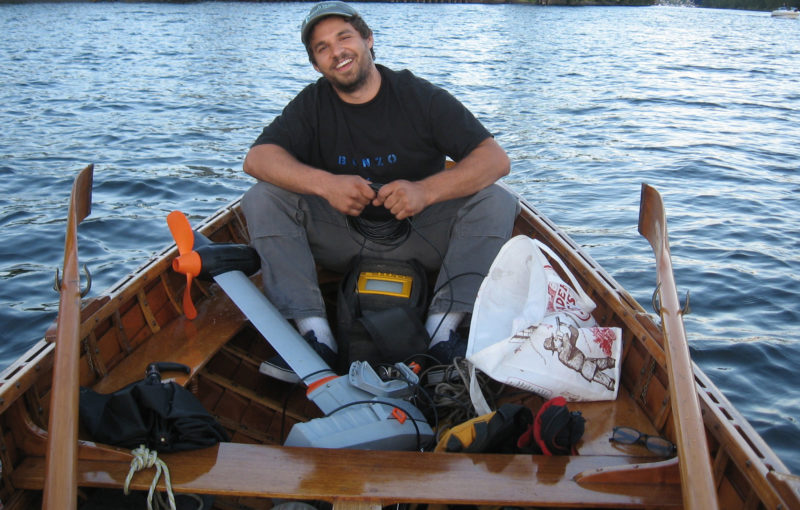
My son, Nate, used an underwater video system to retrieve this outboard that had gone AWOL three days earlier. The yellow video monitor is between his shins and he’s holding the 60′ cable that connects it to the underwater camera.
More recently, I was testing an electric outboard motor that suddenly pried its tiller from my hand, turned sideways, and wrenched itself off the transom. (It’s the very last time I used an outboard without having it tied to a safety line.) The motor went down in about 30′ of water in the middle of the shipping canal, too deep and too dangerous for me to look for it by free-diving. I went home, made a grappling hook out of steel rod, and connected it to a long line and my little underwater video camera. It took three outings at the canal to find the motor, and it was only with my son’s help manning the hook and watching the monitor while I rowed a search pattern and dodged boat traffic that we found and recovered the outboard.
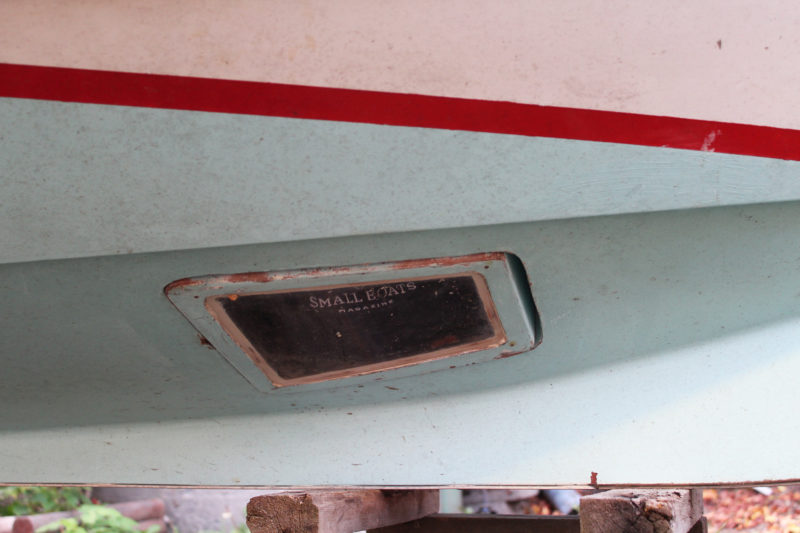
The motorwell on the Caledonia yawl is located just to port of the skeg. The plug that fills the hole when the motor is not in use has a window. The box-like plug is also a handy place to toss my hat.
When I built my Caledonia yawl, I incorporated a simple device for seeing into the water. The plug that fills the motorwell while I’m rowing or sailing has a plexiglass bottom. It comes in handy when I’m sailing in shallow water and need to keep an eye on the bottom, but it has some limitations. When I was exploring the fringes of Yellow Island in Puget Sound’s San Juan archipelago, I got a brief glimpse of the tip of a submerged boulder just before it tore my rudder off.
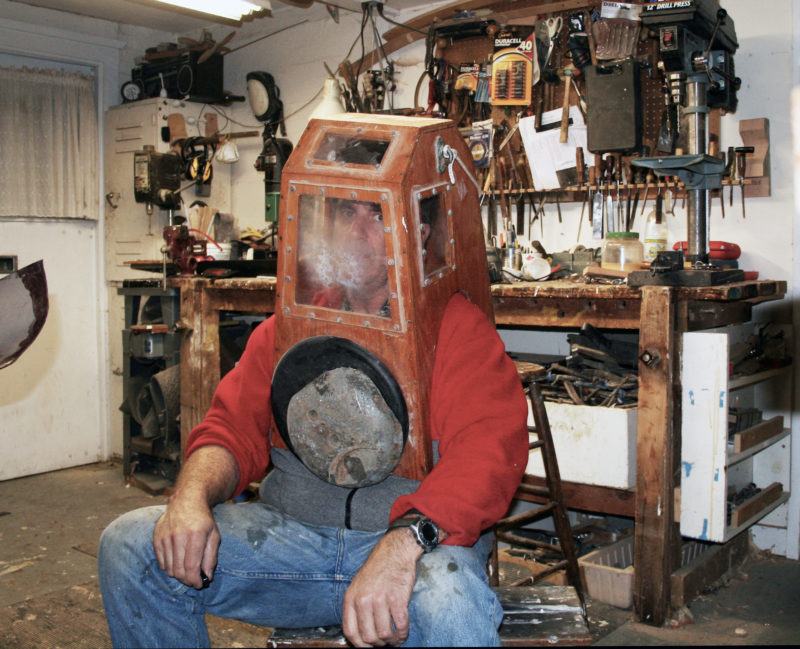
My helmet required weights front and back—about 90 lbs altogether—to get it to sink the volume of air inside it.
I’ve had my best view of the underwater world with a hard-hat diving helmet I made out of plywood and plexiglass. A plastic pump for inflating rafts, manned by someone I can trust, supplies air through a 50’ length of garden hose. I made my first dive with it in a marina, and I was quite content to just sit on the bottom, 12’ down, looking out across the sandy wasteland under the docks. I could have stayed there for quite a while, but I could tell by the diminishing airflow that my pump man was getting tired.
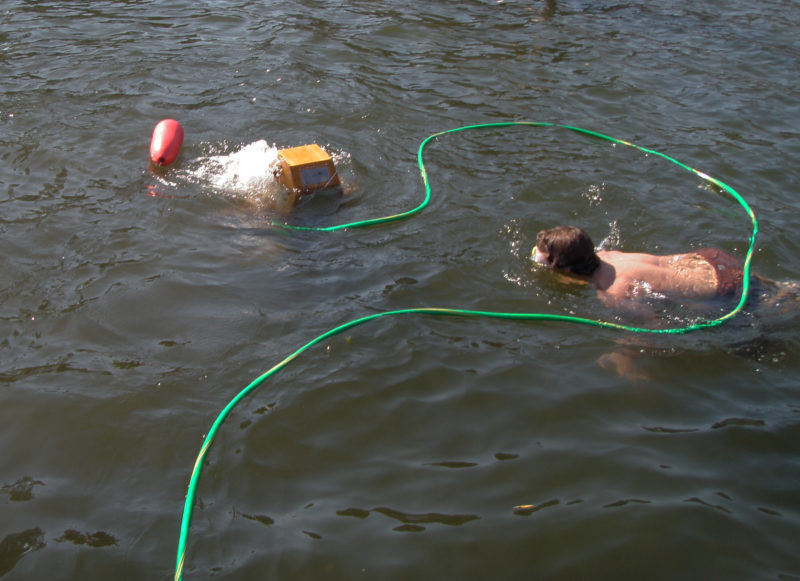
With air pulsing through the garden hose, our friend Bobbie begins his descent while Nate looks on.
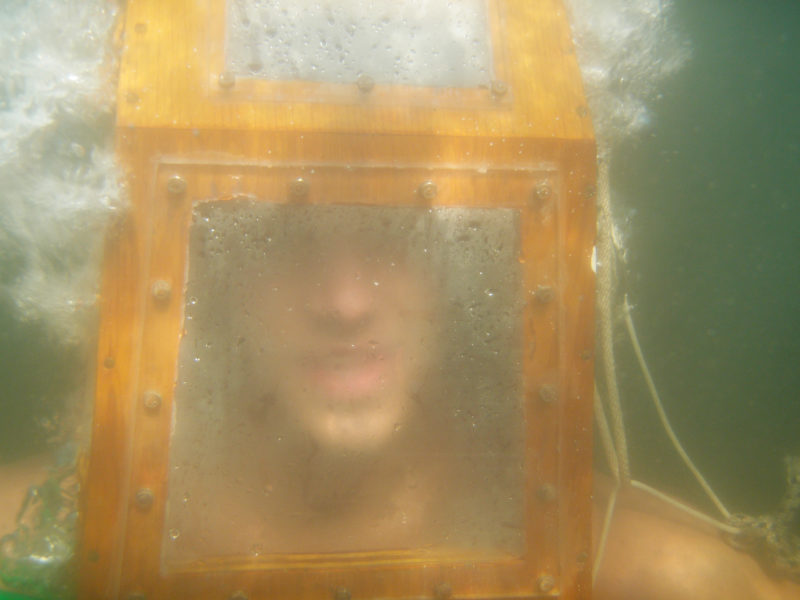
While the helmet’s four windows offer a good view of the underwater world, the noise of the bubbles in the helmet gets to be quite loud. It’s not exactly tranquil.
An easier way to see underwater is through a different kind of windowed plywood box, one used at the surface. On the south coast of Menorca in the Mediterranean, I saw fishermen wading in the shallows, bent over with their faces pressed into things that looked like oversized megaphones. They had openings at the top to fit around their eyes and windows on the bottom. I never found out what they were looking for, but I was intrigued by their devices, called bathyscopes or aquascopes. They’ve been around for quite a while, perhaps almost as long as window glass has been.
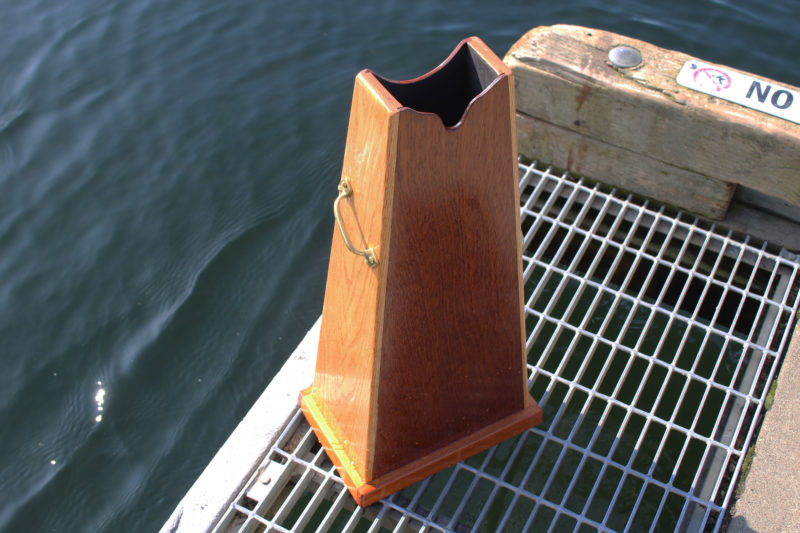
The contoured opening keeps light from getting into the bathyscope and making distracting reflections on the plexiglass window. I’ll add foam strips to the perimeter for comfort.
After worrying for a while about the unfortunate man who’d lost his pants, I made a bathyscope from stuff I had lying around the shop: some leftover mahogany plywood, oak from a desk I’d made years ago, a scrap of 1/4″ plexiglass, and a pair of brass window-sash handles. The top end is 3″ x 5-3/4″ with cutouts for my forehead and nose. I pressed a length of lead-free solder to my face to make a contoured pattern.
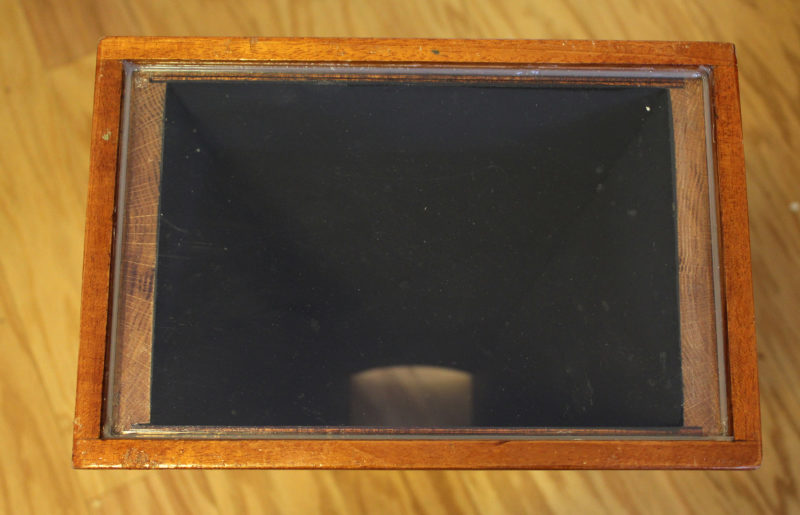
The 1/4″ plexiglass window sits in the recess created by the trim framing the bottom of the bathyscope. A thin bead of silicone caulking, applied only on the outside, makes a watertight seal that will allow easy removal of the plexiglass if it needs to be replaced.
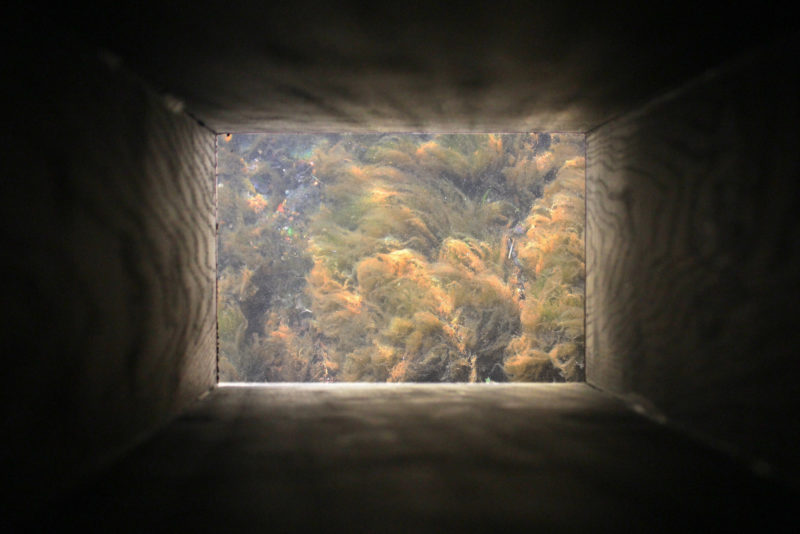
Painting the interior flat black eliminates reflections and improves the view.
The window at the bottom is 7″ x 10″ and recessed in the trim pieces at the bottom so it won’t get scratched when set down. The interior is painted flat black to make the best of the underwater view. The handles are angled for a comfortable grip and offset from one another vertically to provide firmer control if the water’s a bit unsettled.
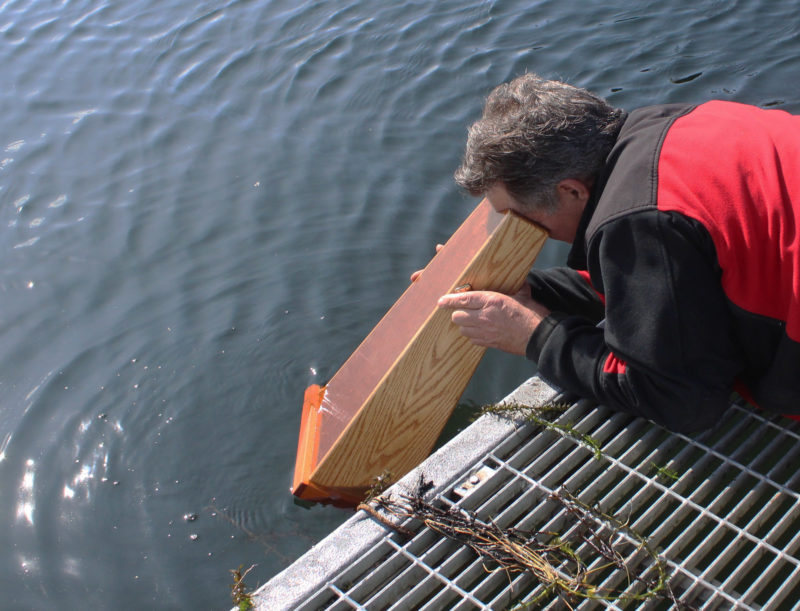
I had a clear view of the bottom off the end of the dock, but I saw no sign of the missing pants, just a shopping cart and a bicycle.
The bathyscope was ready a few days after I’d met the man looking for his pants, so when I returned to the dock with it and a grappling hook I didn’t have much hope of finding the pants, or reconnecting them with their owner if I did. I got a good look at the bike and the shopping cart, guided the hook to them, and hauled them up. There were no markings on the cart, so I’m stuck with that. I took the bike to a service center where the company repairs them. The technician there recognized it as an older model, so it had been missing for quite a long time.
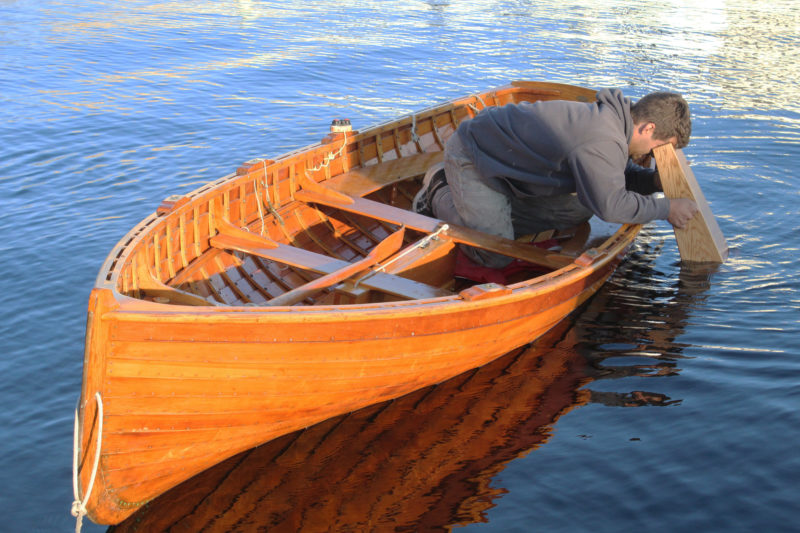
While letting the boat drift at the end of its painter, Nate scanned the bottom for treasure.
With winter coming, the water here will be getting much clearer. I’m planning on rowing around the marina with my bathyscope, grappling hook, and a large magnet. I suspect the water there has been hiding all manner of treasures under its mask of ripples and reflections.![]()

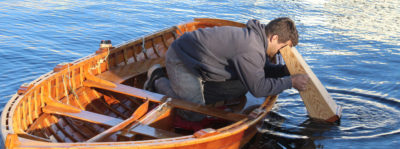


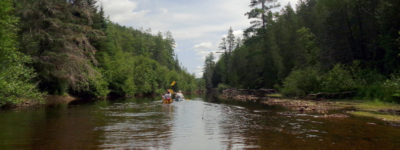
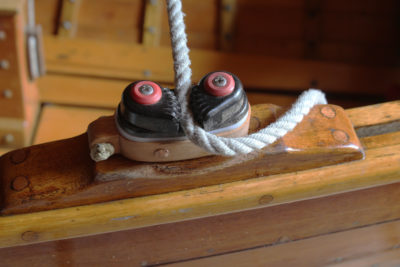
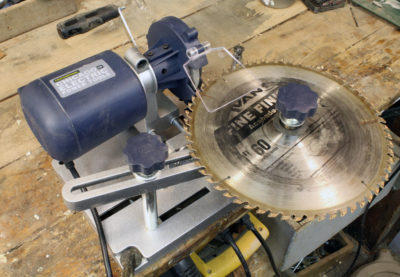
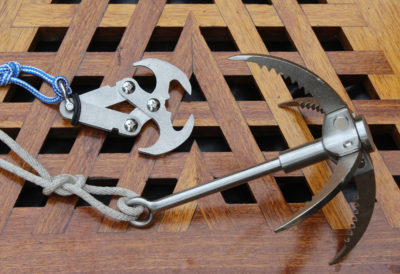

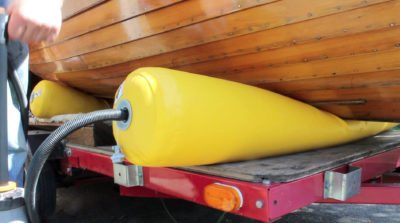
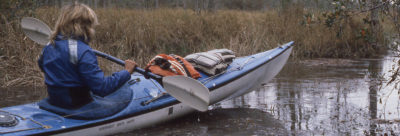


When I was about 16 or so, I built a diving machine modeled (roughly) after military dive pumps worked by a lever handle. The pump cylinders were opposed, so that every stroke sent a pulse of air down the hose. I used shortening cans for cylinders, with pistons made from plywood disks fitted with leather cups. All the other parts were made from wood. The breathing part was a modified WWII army gas mask.
My buddy and I took it down to the lake (Chelan) and dove with it off the swimming dock. After a few minutes, I realized I wasn’t getting any air. When I came up to check, my friend was holding the broken off handle in a gesture of futility.
With a new and improved handle, we were able to get down to about 18 or so feet. When the mask would start to fill up with water, the procedure was to roll over on your back, and let gravity take the water out. The design worked, sort of, but had some serious design flaws. For example, the cylinders were too fat, and the leverage to weak to pump air more than about 15 feet deep. And of course the gas mask was wholly inappropriate for the task.
Later, after a family friend gave me an old worn-out lawn mower engine, I hooked that up to a refrigerator compressor. The first application was to go down to hook up a new chain to the mooring anchor for my dad’s boat. Fortunately, that didn’t take long, as the gas engine blew the exhaust directly into the compressor’s intake.
Nowadays, if parents allowed a kid to do that kind of stuff, they’d be cited for child abuse.
I’m pleased to have a kindred spirit here. I’d like to emphasize Dave’s final comment with a word of caution. Breathing compressed air at depth is dangerous. If you take a deep breath of air in a diving helmet and then bail out and swim to the surface, the air in your lungs will expand as the water pressure decreases. If you don’t exhale on the way up, you can damage your lungs. Using a compressor to deliver air is also dangerous. Even if you can assure that toxic gas-engine exhaust doesn’t get to the diver’s air intake, most compressors lubricate the piston with oil. The oil gets atomized in the air and when the mix is inhaled the oil gets into the lungs. The plastic raft pump I used has no lubrication and operates at a very slow speed. I also had a buoy tied to the helmet with about 12′ of cord; when it was taut, that was the signal to stop descending.
Good story! Those were the days.
That’s awesome!
safety third!
Skipper’s going to need one of these. Let us know what magnet you find. We bought one a while back but it was too small.
I’ll start with this magnet. It has been kicking around the shop for years. We used it once for fishing out of the yawl and didn’t come up with much, but we were using it blind. With the bathyscope we’ll be able to make a quick search of an area and send the magnet down if we see something.

Old old-fashion speakers (thriftshop/dumpster) have very large circular magnets.
Just knock it off, take a wire loop and a long rope. Have fun; find lots of rubbish !
Hi Chris,
I would think that the guys in Menorca were searching for octopus amongst the rocks on the bottom. I have seen the fishermen doing this in the Greek islands.
Enjoying the mag, Whitehall almost finished, will send some photos.
Kind regards,
Barry Biddlecombe in the UK
What a nice and entertaining article–very enjoyable. I really like your ingenuity! Thank you, Christopher!
Ha! We just saw the movie “Mud,” in which one of the characters hunts mussels with a DIY hard hat diving rig!
When I was in first grade, in the ’50s, we lived in Waukegan, Illinois, where divers at the Navy base were still using hard-hat gear. One day a rumor raced through town that one of the divers had surfaced too fast, and that his eyeballs were on his cheeks when they got his helmet off. I never knew if it was a true story, but it still makes my guts crawl to think of it!
I am still in awe as to how I made it to 25 yrs old with all the crazy stuff we did! 64 now. Now just falling down is my biggest worry!
I’m 68 now and I don’t care much for falling either. It seems to hurt a whole lot more than it used to. When I was 21 it didn’t seem at all crazy to risk falling out of the sky.
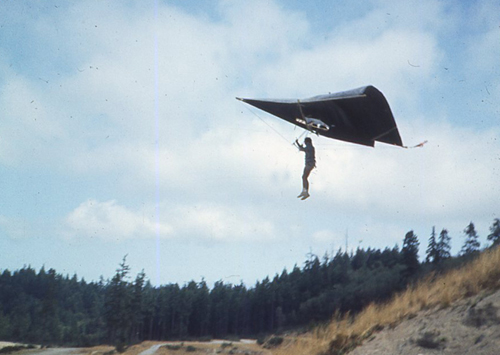
Christopher Cunningham, Editor Small Boats Magazine
Fly no higher than you’re willing to fall. I’ve given up aviation for boats. I’m not willing to fall further than freeboard now days, and not much freeboard at that..
I have stumbled on another very quick and dirty (?) technique for seeing underwater. If you are swimming or diving without a mask, you can carefully cup your hands around your forehead, eyes, and cheeks to make an air/watertight seal. You then blow bubbles into this little air pocket, and you can get a quick clear look around. Of course, the bubble seal only lasts a few seconds, but at least you do get a glance. I have practiced this at the surface, and also when swimming to the bottom of a pool. What I haven’t tried yet, but I’m thinking about, is to use the bubble pocket over the eyes while upside down in the kayak. This suggests the desirability of a reliable roll.